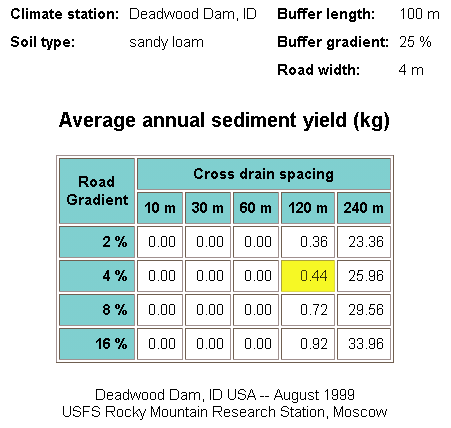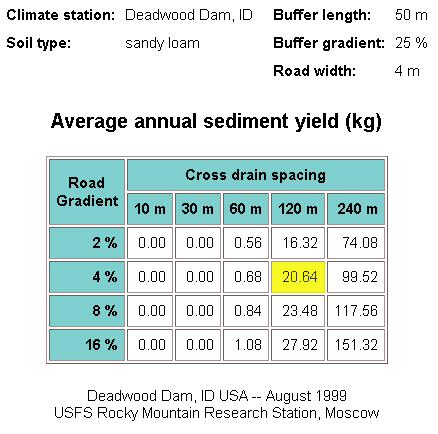
Middle road

Lower road
| Road | Buffer Length (m) | Buffer Slope (%) | Sediment Yield from 120 m (kg) | ||||||||||||
|---|---|---|---|---|---|---|---|---|---|---|---|---|---|---|---|
| Upper | 200 | 60 | 2
| Middle | 100 | 80 50 25 | 0.44 | 9* 21 Lower | 10 | 10 | 85
| * Interpolated Value = 0.44 + (21 - 0.44) / (100 - 50) x (100 - 80) = 9
| | |||
Q There are three old logging roads located on a hillside in the Boise National Forest. Each is 4 m wide. The forest wishes to retain the lowest road possible to allow access for recreational fishing and related wildlife administration. They wish to put in cross drains only every 120 m to allow for ease of maintenance, and to minimize discomfort to road users. The gradients of all three roads are 4 percent. One road is 10 m from the stream with a 10 percent buffer slope, the second is 80 m from the stream with a 25 percent buffer slope, and the third is 200 m from the stream with a 60 percent buffer slope.
Which road should be used?
A A run is made for each condition with the results shown.

Middle road

Lower road
| Road | Buffer Length (m) | Buffer Slope (%) | Sediment Yield from 120 m (kg) | ||||||||||||
|---|---|---|---|---|---|---|---|---|---|---|---|---|---|---|---|
| Upper | 200 | 60 | 2
| Middle | 100 | 80 50 25 | 0.44 | 9* 21 Lower | 10 | 10 | 85
| * Interpolated Value = 0.44 + (21 - 0.44) / (100 - 50) x (100 - 80) = 9
| | |||
These figures indicate that the middle road should be developed for the access, and the lower road should be mitigated in some way to eliminate the risk of sedimentation. The upper road appears to offer little risk from sedimentation due to erosion, but because of its steep gradient, it should be inspected for risk of instability.